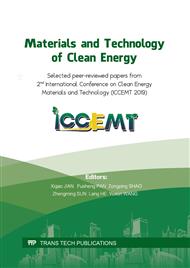[1]
K.H. Lo, C.H. Shek, J.K. Lai, Recent developments in stainless steels, Mater. Sci. Eng. R. 65(2009) 39-104.
Google Scholar
[2]
P. Hosemann, D. Frazer, M. Fratoni, A. Bolind, M.F. Ashby, Materials selection for nuclear applications: Challenges and opportunities. Scripta Materialia, 143(2018) 181-187.
DOI: 10.1016/j.scriptamat.2017.04.027
Google Scholar
[3]
R. Viswanathan, J. Sarver, J.M. Tanzosh, Boiler materials for ultra-supercritical coal power plants - steam side oxidation, J. Mater. Eng. Perform., 15(2006). 255-274.
DOI: 10.1361/105994906x108756
Google Scholar
[4]
S.L. Mannan, M.D. Mathew, T. Jayakumar, S.C. Chetal, Fast reactor technology for energy security: challenges for materials development, Journal of Solid Mechanics and Materials Engineering, 7 (2013) 473-485.
DOI: 10.1299/jmmp.7.473
Google Scholar
[5]
A.F. Rowcliffe, S.J. Zinkle, J.F. Stubbins, D.J. Edwards, D.J. Alexander, Austenitic stainless steels and high strength copper alloys for fusion components, J. Nucl. Mater. 258-263 (1998) 183-192.
DOI: 10.1016/s0022-3115(98)00333-x
Google Scholar
[6]
S.-W. Baek, E.J. Song, J.H. Kim, Y.H. Lee, K.S. Ryu, S.W. Kim, Hydrogen susceptibility of nano-sized oxide dispersed austenitic steel for fusion reactor, Fusion Eng. Des. 121 (2017) 105-110.
DOI: 10.1016/j.fusengdes.2017.06.027
Google Scholar
[7]
Kim H, Jang H, Subramanian G O, Kim C W, Jang C H, Development of alumina-forming duplex stainless steels as accident tolerant fuel cladding materials for light water reactors, Journal of Nuclear Materials, 507 (2018) 1-14.
DOI: 10.1016/j.jnucmat.2018.04.027
Google Scholar
[8]
M.P. Brady, I.G. Wright, B. Gleeson, Alloy design strategies for promoting protective oxide-scale formation, JOM, 52(2000) 16-21.
DOI: 10.1007/s11837-000-0109-x
Google Scholar
[9]
Buckthorpe D. Introduction to Generation IV nuclear reactors, in Structural Materials for Generation IV Nuclear Reactors [M]. Elsevier, (2017).
DOI: 10.1016/b978-0-08-100906-2.00001-x
Google Scholar
[10]
M.P. Brady, J. Magee, Y. Yamamoto, D. Helmick, and L. Wang, Co-optimization of wrought alumina-forming austenitic stainless steel composition ranges for high-temperature creep and oxidation/corrosion resistance, Mater. Sci. Eng. A, 590(2014) 101-115.
DOI: 10.1016/j.msea.2013.10.014
Google Scholar
[11]
Y. Yamamoto, M.P. Brady, Z.P. Lu, P.J. Maziasz, C.T. Liu, B.A. Pint, K.L. More, H.M. Meyer, E.A. Payzant, Creep-resistant, Al2O3-forming austenitic stainless steel, Sci., 316(2007) 433-436.
DOI: 10.1126/science.1137711
Google Scholar
[12]
J. Ejenstam, P. Szakálos. Long term corrosion resistance of alumina forming austenitic stainless steels in liquid lead, Journal of Nuclear Materials, 461(2015) 164-170.
DOI: 10.1016/j.jnucmat.2015.03.011
Google Scholar
[13]
Y. Yamamoto, M.P. Brady, Z.P. Lu, C.T. Liu, M. Takeyama, P.J. Maziasz, B.A. Pint, Alumina-forming austenitic stainless steels strengthened by Laves Phase and MC carbide precipitates, Metall. Mater. Trans. A, 38A(2007). 2737-2746.
DOI: 10.1007/s11661-007-9319-y
Google Scholar
[14]
Wuxin Zhao, Yuan Wu, Suihe Jiang, Hui Wang, Xiongjun Liu, Zhaoping Lv, Micro-alloying effects of Yttrium on Recrystallization Behavior of an Alumina-forming Austenitic Stainless Steel, Journal of Iron and steel research, international, 23(2016) 553-558.
DOI: 10.1016/s1006-706x(16)30087-5
Google Scholar
[15]
Geneva Trotter, Garrett Rayner, Ian Baker, Paul R. Munroe, Accelerated precipitation in the AFA stainless steel Fee20Cr-30Ni-2Nb-5Al via cold working, Intermetallics 53(2014) 120-128.
DOI: 10.1016/j.intermet.2014.04.018
Google Scholar
[16]
Min-Ho Jang, Joonoh Moon, Jun-Yun Kang, Heon-Young Ha, BaigGyu Choi, Tae-Ho Lee, Changhee Lee, Effect of tungsten addition on high-temperature properties and microstructure of alumina-forming austenitic heat-resistant steels , Mater. Sci. Eng. A, 647(2015) 163-169.
DOI: 10.1016/j.msea.2015.09.018
Google Scholar
[17]
Bingbing Zhao, Jifu Fan, Yize Liu, Lin Zhao, Xianping Dong, Feng Sun, Lanting Zhang, Formation of L12-ordered precipitation in an alumina-forming austenitic stainless steel via Cu addition and its contribution to creep/rupture resistance, Scripta Materialia 109 (2015) 64-67.
DOI: 10.1016/j.scriptamat.2015.07.019
Google Scholar
[18]
D.H. Wen, Z. Li, B.B. Jiang, Q. Wang, G.Q. Chen, R. Tang, R.Q. Zhang, C. Dong, Peter K. Liaw, Effects of Nb/Ti/V/Ta on phase precipitation and oxidation resistance at 1073 K in alumina-forming austenitic stainless steels, Materials Characterization 144 (2018) 86-98.
DOI: 10.1016/j.matchar.2018.07.007
Google Scholar
[19]
M. Wang, H.Y. Sun, M. Phaniraj, H.N. Han, J.S. Jang, Z.J. Zhou, Evolution of microstructure and tensile properties of Fe–18Ni–12Cr based AFA steel during aging at 700 oC, Mater. Sci. Eng. A, 672(2016) 23-31.
DOI: 10.1016/j.msea.2016.06.060
Google Scholar
[20]
Wang M, Sun Y, Feng J, Zhang R, Tang R, Zhou Z, Microstructural evolution and mechanical properties of an Fe-18Ni-16Cr-4Al base alloy during aging at 950 °C, International Journal of Minerals Metallurgy and Materials. 23 (2016) 314-322.
DOI: 10.1007/s12613-016-1240-1
Google Scholar
[21]
Joonoh Moon, Tae-Ho Lee, Yoon-Uk Heo, Young-Soo Han, Jun-Yun Kang, Heon-Young Ha Dong-Woo Suh, Precipitation sequence and its effect on age hardening of alumina-forming austenitic stainless steel, Materials Science & Engineering A 645 (2015) 72-81.
DOI: 10.1016/j.msea.2015.08.005
Google Scholar
[22]
Ian Baker, Natalie Afonina, Zhangwei Wang, Margaret Wu, Preliminary creep testing of the alumina-forming austenitic stainless steel Fe-20Cr-30Ni-2Nb-5Al, Materials Science & Engineering A 718 (2018) 492-498.
DOI: 10.1016/j.msea.2018.01.090
Google Scholar
[23]
M.P. Brady, K.A. Unocic, M.J. Lance, M.L. Santella, Y. Yamamoto, and L.R. Walker, Increasing the Upper Temperature Oxidation Limit of Alumina Forming Austenitic Stainless Steels in Air with Water Vapor, Oxid. Met., 75(2011) 337-357。.
DOI: 10.1007/s11085-011-9237-7
Google Scholar
[24]
M.P. Brady, Y. Yamamoto, M.L. Santella, L.R. Walker, Composition, microstructure, and water vapor effects on internal/external oxidation of alumina-forming austenitic stainless steels, Oxid. Met. 72 (2009) 311-333.
DOI: 10.1007/s11085-009-9161-2
Google Scholar
[25]
B.A. Pint, Optimization of reactive-element additions to improve oxidation performance of alumina-forming alloys, J. Am. Ceram. Soc. 86 (2003) 686-695.
DOI: 10.1111/j.1151-2916.2003.tb03358.x
Google Scholar
[26]
Sun S, Zhou Z, Zhang L, Tang R, Oxidation behavior and Stress Corrosion Cracking Susceptibility of Fe27Ni16Cr3.5Al based AFA Alloy in Supercritical Water, Mater. Res. Express 5 (2018) 066525.
DOI: 10.1088/2053-1591/aac989
Google Scholar
[27]
Hao Shi, Adrian Jianu, Alfons Weisenburger, Chongchong Tang, Annette Heinzel, Renate Fetzer, Fabian Lang, Robert Stieglitz, Georg Müller, Corrosion resistance and microstructural stability of austenitic FeeCreAleNi model alloys exposed to oxygen-containing molten lead, Journal of Nuclear Materials 524 (2019) 177-190.
DOI: 10.1016/j.jnucmat.2019.06.043
Google Scholar


